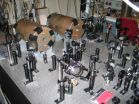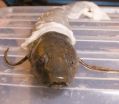(Press-News.org) Jerusalem, November 8, 2010 – Research carried out in Mali, West Africa, has demonstrated that a new, safe and uncomplicated insect control method, developed at the Hebrew University of Jerusalem, can bring about a serious decline in malaria-bearing mosquitoes in afflicted regions in the world.
The research in Africa was based on work carried out earlier in Israel by researchers at the Kuvin Center for the Study of Tropical and Infectious Diseases at the Hebrew University of Jerusalem that showed how attractants of plant origin (fruit or flowers) with a toxic sugar bait can reduce the populations of the malaria-transmitting mosquitoes.
Their work is detailed in a recent issue of the Malaria Journal. The scientists involved in the project are Prof. Yosef Schlein and Dr. Gunter C . Muller of the Kuvin Center and the Institute for Medical Research Israel-Canada (IMRIC), Prof. John C. Beier of the University of Miami, Florida, and Prof. Sekou F. Traore, Prof. Seydou Doumbia, Dr. Mahamadou B. Toure, Dr. Mohamed B. Traore and Dr. Sekou Bah, all of the University of Bamako, Mali.
Their work in the use of the Hebrew University-developed Attractive Toxic Sugar Bait Method (ATSB) was applied to control malaria-bearing mosquitoes in the semi-arid Bandiagara District of Mali, West Africa.
Control and treatment sites were selected along a road that connects villages and that had man-made ponds that were the primary larval habitats of Anopheles gambiae and Anopheles arabiensis mosquitoes. Guava and honey melons, two local fruits that have been found to be attractive to both species of mosquitoes, were used to prepare solutions of Attractive Sugar Bait (ASB) and ATSB, the latter containing an additive of boric acid as an oral insecticide. Both included a color dye marker to facilitate determination of mosquitoes feeding on the solutions.
ASB solution in the control site and ATSB solution in the treatment site were sprayed on patches of the vegetation. Consequently, it was seen that the relative abundance of female and male mosquitoes in the ATSB-treated site declined dramatically by about 90% and remained low during one month of monitoring. The females in the diminished population were mostly too young to transmit malaria. In parallel, dye marking in the solutions sprayed in the control site provided evidence that most of the mosquitoes were feeding on the sprayed solutions.
The researchers concluded that the study in Mali shows that even a single application of ATSB can substantially decrease malaria-bearing mosquito population densities and longevity. It is thus likely that ATSB methods can be used as a new, powerful tool for the control of malaria insect carriers, since this approach is highly effective for mosquito control, technologically simple, inexpensive and environmentally safe.
The work in Mali is very much connected to Bill and Melinda Gates Foundation funding of early studies, and this initial report can set the stage for bigger efforts in African countries. It is one of the first new dimensions to control African malaria vectors, yielding good indications that use of ATSB in outdoor environments will complement the current measures to control mosquitoes inside houses.
INFORMATION:
Hebrew University-developed method for control of malaria applied in Africa
2010-11-09
ELSE PRESS RELEASES FROM THIS DATE:
Fat cells reach their limit and trigger changes linked to type 2 diabetes
2010-11-09
Scientists have found that the fat cells and tissues of morbidly obese people and animals can reach a limit in their ability to store fat appropriately. Beyond this limit several biological processes conspire to prevent further expansion of fat tissue and in the process may trigger other health problems.
Research funded by the Biotechnology and Biological Sciences Research Council (BBSRC), the Medical Research Council (MRC) and the European Union Sixth Framework Programme, shows that a protein called secreted frizzled-related protein 1 (SFRP1) is produced by fat cells ...
Researchers in Bonn find an 'altruism gene'
2010-11-09
Do you like to do good things for other people? If so, your genes might be responsible for this. At least, the results of a study conducted by researchers of the University of Bonn suggest this. According to the study, a minute change in a particular gene is associated with a significantly higher willingness to donate. People with this change gave twice as much money on average to a charitable cause as did other study subjects. The results have now been published in the journal Social Cognitive & Affective Neuroscience (doi: 10.1093/scan/nsq083).
The researchers working ...
Quantum memory for communication networks of the future
2010-11-09
Researchers from the Niels Bohr Institute at the University of Copenhagen have succeeded in storing quantum information using two 'entangled' light beams. Quantum memory or information storage is a necessary element of future quantum communication networks. The new findings are published in Nature Physics.
Quantum networks will be able to protect the security of information better than the current conventional communication networks. The cornerstone of quantum communication is a phenomenon called entanglement between two quantum systems, for example, two light beams. ...
Graphene gets a Teflon makeover
2010-11-09
Professor Andre Geim, who along with his colleague Professor Kostya Novoselov won the 2010 Nobel Prize for graphene – the world's thinnest material, has now modified it to make fluorographene – a one-molecule-thick material chemically similar to Teflon.
Fluorographene is fully-fluorinated graphene and is basically a two-dimensional version of Teflon, showing similar properties including chemical inertness and thermal stability.
The results are this week reported in the advanced online issue of the journal Small. The work is a large international effort and involved ...
Were our tetrapod ancestors deaf?
2010-11-09
Many changes in the sensory systems of tetrapods are associated with the water-to-land transition. In hearing, one of the crucial elements in detecting airborne sound is the tympanic ear. Surprisingly, the tympanic ear originated independently in the major tetrapod lineages and relatively late after the terrestrial tetrapods emerged – in the Triassic, more than 100 million years after the origin of tetrapods. The major question raised by the researchers Jakob Christensen-Dalsgaard, Christian Brandt and Magnus Wahlberg, University of Southern Denmark, and Maria Wilson and ...
Privacy safeguards in Canadian military insufficient: Updated rules needed
2010-11-09
Privacy legislation and protocols to safeguard the health information of members of the military are lacking, and the head of Canada's military must take action to ensure health privacy for all staff, states an editorial in the Canadian Medical Association Journal (CAMJ) http://www.cmaj.ca/cgi/doi/10.1503/cmaj.101630.
Recent violations at Veterans Affairs Canada of privacy regarding sensitive health information raise questions about the military's ability to protect personal health information.
"Few of the world's armed forces provide complete confidentiality of personal ...
Mild painkillers in pregnancy are associated with an increased risk of male reproductive problems
2010-11-09
New evidence has emerged that the use of mild painkillers such as paracetamol, aspirin and ibuprofen, may be part of the reason for the increase in male reproductive disorders in recent decades. Research published in Europe's leading reproductive medicine journal Human Reproduction today (Monday 8 November) shows that women who took a combination of more than one mild analgesic during pregnancy, or who took the painkillers during the second trimester of pregnancy, had an increased risk of giving birth to sons with undescended testicles (cryptorchidism) – a condition that ...
Scientists pinpoint key defense against parasite infection
2010-11-09
Scientists have made a significant discovery about how the body defends itself against snail fever, a parasitic worm infection common in developing countries.
Researchers studied the immune response in mice infected with snail fever parasites. They found that a particular type of immune cell, known as the dendritic cell, is responsible for triggering the immune system's defence against the invading parasite.
The development, by scientists at the University of Edinburgh, could point towards new avenues of research into treatments for the condition, which causes long-term ...
Study examines risk of heterosexual HIV transmission in China
2010-11-09
A new study by researchers at the Johns Hopkins Bloomberg School of Public Health examines the burden of HIV and sexually transmitted disease among male clients of the commercial sex industry in China's Sichuan province. Since 2007, heterosexual transmission has replaced injecting drug use as the primary transmission mode of all HIV infections in China. The study is available online in advance of publication in the journal Sexually Transmitted Infections.
"We found a large burden of syphilis infection coupled with high-risk sexual and substance use behaviors among male ...
Scientist chronicle nanoparticles' journey from the lungs into the body
2010-11-09
BOSTON – Using a novel, real-time imaging system, scientists have tracked a group of near-infrared fluorescent nanoparticles from the airspaces of the lungs, into the body and out again, providing a description of the characteristics and behavior of these minute particles which could be used in developing therapeutic agents to treat pulmonary disease, as well as offering a greater understanding of the health effects of air pollution.
Led by investigators at Beth Israel Deaconess Medical Center (BIDMC) and the Harvard School of Public Health, the findings are described ...


